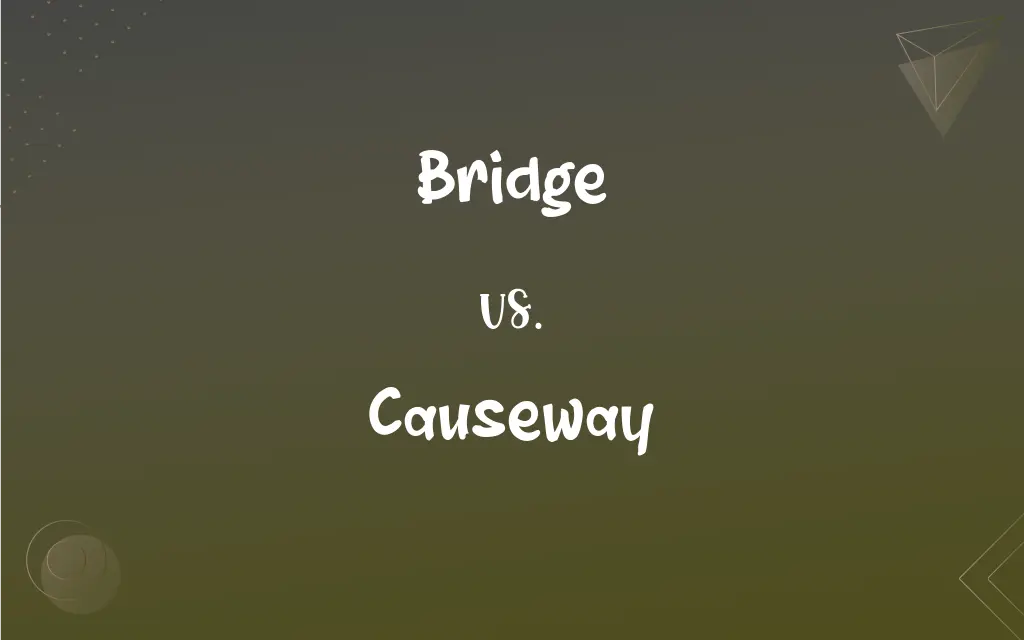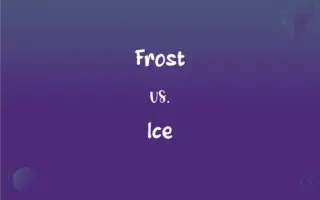Bridge vs. Causeway: What's the Difference?
Edited by Aimie Carlson || By Janet White || Updated on October 4, 2023
A Bridge is a structure built to span a physical obstacle, such as water or a road, while a Causeway is a raised road or track across low or wet ground.

Key Differences
A Bridge is an architectural marvel often spanning across rivers, chasms, or roads, allowing for transportation over these obstacles. On the other hand, a Causeway specifically addresses the challenge of low, swampy, or wet terrains by elevating the road or path above the ground level.
Building a Bridge often involves intricate engineering solutions to ensure it remains stable and can bear loads, even in the middle of wide expanses of water or valleys. Meanwhile, a Causeway might be constructed using materials like rocks, earth, or wood, creating a solid path in marshy areas or across shallow waters.
Tourists might flock to see a beautifully designed suspension Bridge or an ancient stone bridge with historical significance. However, a Causeway might be noted for its length, such as the famous Overseas Highway in Florida, stretching across the ocean and connecting islands.
While a Bridge may exist in various forms - arch, beam, truss, or cantilever, a Causeway typically presents as a straightforward, elevated roadway. Some causeways might include small bridges or viaducts to allow water to flow underneath.
In urban settings, a Bridge can be a pedestrian walkway connecting two buildings or areas. In contrast, a Causeway in such settings would be unusual, as they are more often found in areas with waterlogged terrains or between land masses across water bodies.
ADVERTISEMENT
Comparison Chart
Definition
A structure spanning and providing passage over a gap or barrier.
A raised road or path across low or wet ground.
Common Usage
Overcome obstacles like rivers, chasms.
Navigate through wet, swampy terrains or shallow waters.
Structural Complexity
Can be complex with arches, suspension systems.
Generally straightforward, elevated roadways.
Typical Location
Over rivers, valleys, roads.
Marshlands, between islands, across shallow waters.
Materials Used
Concrete, steel, wood, stone.
Rocks, earth, wood, sometimes concrete.
ADVERTISEMENT
Bridge and Causeway Definitions
Bridge
The part of a pair of glasses that goes over the nose.
The Bridge of her glasses was adorned with a small diamond.
Causeway
A paved or raised way in water used for walking.
Tourists strolled down the Causeway along the beach at sunset.
Bridge
A raised platform on a ship from which the ship is commanded.
The captain stood on the Bridge giving orders during the storm.
Causeway
An embankment to prevent flooding.
The village built a Causeway to protect their fields from tidal surges.
Bridge
A structure spanning and providing passage over a gap or barrier, such as a river or roadway.
Causeway
A means of connection between separated points.
The Causeway facilitated trade between the two coastal towns.
Bridge
Something resembling or analogous to this structure in form or function
A land bridge between the continents.
A bridge of understanding between two countries.
Causeway
A road that is raised above water or marshland.
Driving on the Causeway offers beautiful views of the marsh.
Bridge
The upper bony ridge of the human nose.
Causeway
A raised road or track across low or wet ground.
The Causeway connected the two islands, making travel easier.
Bridge
The part of a pair of eyeglasses that rests against this ridge.
Causeway
A roadway on a raised bed of earth, rubble, or other fill, usually crossing open water or a wetland.
Bridge
A fixed or removable replacement for one or several but not all of the natural teeth, usually anchored at each end to a natural tooth.
Causeway
A long bridge consisting of many short spans.
Bridge
A thin, upright piece of wood in some stringed instruments that supports the strings above the soundboard.
Causeway
(Archaic) A paved highway.
Bridge
A transitional passage connecting two subjects or movements.
Causeway
A road that is raised so as to be above water, marshland, and similar low-lying obstacles. Originally causeways were much like dykes, generally pierced to let water through, whereas many modern causeways are more like bridges or viaducts.
Bridge
(Nautical) A crosswise platform or enclosed area above the main deck of a ship from which the ship is controlled.
Causeway
To pave, to cobble.
Bridge
A long stick with a notched plate at one end, used to steady the cue in billiards. Also called rest1.
Causeway
A way or road raised above the natural level of the ground, serving as a dry passage over wet or marshy ground.
But that broad causeway will direct your way.
The other way Satan went downThe causey to Hell-gate.
Bridge
The hand used as a support to steady the cue.
Causeway
A road that is raised above water or marshland or sand
Bridge
Any of various instruments for measuring or comparing the characteristics, such as impedance or inductance, of a conductor.
Causeway
Provide with a causeway;
A causewayed swamp
Bridge
An electrical shunt.
Causeway
Pave a road with cobblestones or pebbles
Bridge
(Chemistry) An intramolecular connection that spans atoms or groups of atoms.
Bridge
Any of several card games derived from whist, usually played by four people in two partnerships, in which trump is determined by bidding and the hand opposite the declarer is played as a dummy.
Bridge
To build a bridge over.
Bridge
To cross by or as if by a bridge.
Bridge
A construction or natural feature that spans a divide.
Bridge
A construction spanning a waterway, ravine, or valley from an elevated height, allowing for the passage of vehicles, pedestrians, trains, etc.
The rope bridge crosses the river.
Bridge
(anatomy) The upper bony ridge of the human nose.
Rugby players often break the bridge of their noses.
Bridge
(dentistry) A prosthesis replacing one or several adjacent teeth.
The dentist pulled out the decayed tooth and put in a bridge.
Bridge
(bowling) The gap between the holes on a bowling ball
Bridge
An arch or superstructure.
Bridge
(nautical) An elevated platform above the upper deck of a mechanically propelled ship from which it is navigated and from which all activities on deck can be seen and controlled by the captain, etc; smaller ships have a wheelhouse, and sailing ships were controlled from a quarterdeck.
The first officer is on the bridge.
Bridge
The piece, on string instruments, that supports the strings from the sounding board.
Bridge
A particular form of one hand placed on the table to support the cue when making a shot in cue sports.
Bridge
A cue modified with a convex arch-shaped notched head attached to the narrow end, used to support a player's (shooter's) cue for extended or tedious shots. Also called a spider.
Bridge
Anything supported at the ends and serving to keep some other thing from resting upon the object spanned, as in engraving, watchmaking, etc., or which forms a platform or staging over which something passes or is conveyed.
Bridge
(wrestling) A defensive position in which the wrestler is supported by his feet and head, belly-up, in order to prevent touch-down of the shoulders and eventually to dislodge an opponent who has established a position on top.
Bridge
(gymnastics) A similar position in gymnastics.
Bridge
A connection, real or abstract.
Bridge
(medicine) A rudimentary procedure before definite solution
ECMO is used as a bridge to surgery to stabilize the patient.
Bridge
(computing) A device which connects two or more computer buses, typically in a transparent manner.
This chip is the bridge between the front-side bus and the I/O bus.
Bridge
(programming) A software component connecting two or more separate systems.
Bridge
(networking) A system which connects two or more local area networks at layer 2 of OSI model.
The LAN bridge uses a spanning tree algorithm.
Bridge
(chemistry) An intramolecular valence bond, atom or chain of atoms that connects two different parts of a molecule; the atoms so connected being bridgeheads.
Bridge
(electronics) An unintended solder connection between two or more components or pins.
Bridge
(music) A contrasting section within a song that prepares for the return of the original material section.
The lyrics in the song's bridge inverted its meaning.
In the bridge of his 2011 song "It Will Rain", Bruno Mars begs his lover not to "say goodbye."
Bridge
(graph theory) An edge which, if removed, changes a connected graph to one that is not connected.
Bridge
(poetry) A point in a line where a break in a word unit cannot occur.
Bridge
(diplomacy) A statement, such as an offer, that signals a possibility of accord.
Bridge
A day falling between two public holidays and consequently designated as an additional holiday.
Bridge
(electronics) Any of several electrical devices that measure characteristics such as impedance and inductance by balancing different parts of a circuit
Bridge
A low wall or vertical partition in the fire chamber of a furnace, for deflecting flame, etc.; a bridge wall.
Bridge
(cycling) The situation where a lone rider or small group of riders closes the space between them and the rider or group in front.
Bridge
A solid crust of undissolved salt in a water softener.
Bridge
(roller derby) An elongated chain of teammates, connected to the pack, for improved blocking potential.
Bridge
(card games) A card game played with four players playing as two teams of two players each.
Bidding is an essential element of the game of bridge.
Bridge
To be or make a bridge over something.
With enough cable, we can bridge this gorge.
Bridge
To span as if with a bridge.
The two groups were able to bridge their differences.
Bridge
(music) To transition from one piece or section of music to another without stopping.
We need to bridge that jam into "The Eleven".
Bridge
To connect two or more computer buses, networks etc. with a bridge.
Bridge
(wrestling) To go to the bridge position.
Bridge
(roller derby) To employ the bridge tactic. (See Noun section.)
Bridge
A structure, usually of wood, stone, brick, or iron, erected over a river or other water course, or over a chasm, railroad, etc., to make a passageway from one bank to the other.
Bridge
Anything supported at the ends, which serves to keep some other thing from resting upon the object spanned, as in engraving, watchmaking, etc., or which forms a platform or staging over which something passes or is conveyed.
Bridge
The small arch or bar at right angles to the strings of a violin, guitar, etc., serving of raise them and transmit their vibrations to the body of the instrument.
Bridge
A device to measure the resistance of a wire or other conductor forming part of an electric circuit.
Bridge
A low wall or vertical partition in the fire chamber of a furnace, for deflecting flame, etc.; - usually called a bridge wall.
Bridge
A card game resembling whist.
Bridge
To build a bridge or bridges on or over; as, to bridge a river.
Their simple engineering bridged with felled trees the streams which could not be forded.
Bridge
To open or make a passage, as by a bridge.
Xerxes . . . over HellespontBridging his way, Europe with Asia joined.
Bridge
To find a way of getting over, as a difficulty; - generally with over.
Bridge
A structure that allows people or vehicles to cross an obstacle such as a river or canal or railway etc.
Bridge
A circuit consisting of two branches (4 arms arranged in a diamond configuration) across which a meter is connected
Bridge
Something resembling a bridge in form or function;
His letters provided a bridge across the centuries
Bridge
The hard ridge that forms the upper part of the nose;
Her glasses left marks on the bridge of her nose
Bridge
Any of various card games based on whist for four players
Bridge
A wooden support that holds the strings up
Bridge
A denture anchored to teeth on either side of missing teeth
Bridge
The link between two lenses; rests on nose
Bridge
An upper deck where a ship is steered and the captain stands
Bridge
Connect or reduce the distance between
Bridge
Make a bridge across;
Bridge a river
Bridge
Cross over on a bridge
Bridge
A structure carrying a pathway or road over an obstacle.
The Golden Gate Bridge spans the entrance to San Francisco Bay.
Bridge
A connecting, transitional, or intermediate route or phase.
The internship served as a Bridge between school and her career.
Bridge
A dental replacement supported by natural teeth.
After the accident, he needed a Bridge to replace the missing teeth.
FAQs
What's the primary function of a Bridge?
A Bridge provides passage over a gap or barrier like rivers or roads.
Where would you typically find a Causeway?
A Causeway is often found across low, wet grounds or between islands.
Can a Causeway be submerged during high tide?
Yes, some Causeways can be submerged during high tide and become visible during low tide.
Are Bridges always over water?
No, a Bridge can span over various obstacles, including roads, valleys, and chasms.
Are Causeways always straight?
While typically straightforward, Causeways can have curves or bends based on terrain.
Is a viaduct a type of Bridge?
Yes, a viaduct is a type of Bridge that spans over valleys or other roads.
Can Causeways have small bridges in them?
Yes, Causeways can incorporate small bridges to allow water flow.
Can Causeways impact the environment?
Yes, Causeways can affect water flow, marine life, and local ecosystems.
Do Bridges only cater to vehicular traffic?
No, Bridges can be designed for pedestrians, vehicles, trains, or a combination of these.
What materials are Causeways typically made from?
Causeways are often made from rocks, earth, wood, and sometimes concrete.
What supports the middle of a large Bridge?
Large Bridges often use pillars, arches, or suspension systems for support.
Which is generally longer, a Bridge or a Causeway?
It varies, but Causeways, especially those connecting land masses, can often be longer than typical bridges.
How are Causeways different from dykes?
While both are raised embankments, a Causeway is primarily for transportation, while a dyke prevents flooding.
What is a footbridge?
A footbridge is a Bridge designed specifically for pedestrians.
Can Bridges be movable?
Yes, some Bridges, like drawbridges or bascule bridges, can move to allow ship passage.
Can a Bridge be a symbolic term?
Yes, a Bridge can symbolize connection, transition, or overcoming obstacles.
Is a Causeway always elevated?
Primarily, a Causeway is elevated to provide a dry path over wet areas.
Why might a Causeway be important for an island community?
A Causeway can connect island communities to the mainland, facilitating travel and trade.
What is a covered Bridge?
A covered Bridge has a roof and siding, often made of wood, providing shelter.
How long can Causeways be?
Causeways can vary in length, with some spanning several miles, connecting islands or land masses.
About Author
Written by
Janet WhiteJanet White has been an esteemed writer and blogger for Difference Wiki. Holding a Master's degree in Science and Medical Journalism from the prestigious Boston University, she has consistently demonstrated her expertise and passion for her field. When she's not immersed in her work, Janet relishes her time exercising, delving into a good book, and cherishing moments with friends and family.
Edited by
Aimie CarlsonAimie Carlson, holding a master's degree in English literature, is a fervent English language enthusiast. She lends her writing talents to Difference Wiki, a prominent website that specializes in comparisons, offering readers insightful analyses that both captivate and inform.
































































